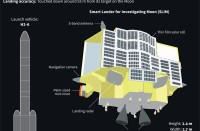
NEWCASTLE, England (Reuters) — What do you get if you put an architect, civil engineer, computer scientist, and microbiologist into a room? A future building that grows its own foundations.
This might sound like a less than funny joke. In fact, it’s the result of a unique project launched by researchers at the universities of Newcastle and Northumbria, in England, to create a new generation of building materials that are partly living and able to respond meaningfully to their environment.
The futuristic plan involves engineering individual bacterial cells that react to changes in the environment and strengthen the soil around them, potentially rendering traditional building foundations obsolete.
The project is the brainchild of Dr Martyn Dade-Robertson, reader in design computation, at Newcastle University. He’s an architect with a degree in synthetic biology who wants to combine his two areas of expertise to revolutionise the world of construction.
He told Reuters: “What we want to do is design a type of bacteria that would detect the mechanical changes in soil, essentially synthesising materials so they would make materials in response, strengthening the soils where construction loads are. The first part of that has been to identify pressure sensing genes, genes in the bacteria that will respond to relatively low levels of pressure – and we can use that as a switch, effectively to turn on a process of material synthesis in the bacteria.”
Researchers have identified dozens of genes in E. Coli bacteria, modifying the bacteria to create a ‘gene circuit’ that enables the bacteria to respond to its environment by producing ‘biocements’.
“Bacteria make all kinds of different materials, but we’re particularly interested in bio-mineralisation,” said Dade-Robertson. “They release a chemical into their own environment which changes its pH (potential of hydrogen) and then can lead to calcium carbonate crystals forming – so effectively limestone. You trigger that process and the soil grains start to bind together, effectively gluing the soil grains together so you get this resistance to the new material.”
The team hopes to develop such responsive material in three-dimensional form and have it tested by force within three years. The project depends on receiving a further round of funding, and the team is waiting to hear whether its grant proposal has been successful.
Dade-Robertson says that, although the project is currently ‘blue skies thinking’, it is feasible that it could be ready for use in real construction projects within a decade.
Biocement, self-healing material that can improve the durability of building structures, is already in use. Dade-Robertson says this project takes the concept much further.
He said: “Think of the amount of energy and time that it takes to build up foundation trenches, and we fill them with concrete reinforcement. The idea is that we want to make the ground receptive to the loads that are placed on it. As you load the ground you would have these pressures within this material and the ground essentially intelligently responding to those pressures by reinforcing itself, so you could construct large-scale civil engineering projects without digging those foundation trenches, by essentially seeding the ground with these microscopic bacteria.”
The concept has environmental implications too, being a potentially carbon negative way to build foundations. “The purpose of a project like this is to make materials very efficiently, so that our structures require very little energy input, and so they’re responsive and intelligent to their environmental constraints,” he said.
The team has also developed a new type of Computer Aided Design (CAD) application which models the pressures and stresses within soil under a building and maps different types of gene expression, predicting where the bacteria are likely to produce materials.
The research hasn’t been published in a peer-reviewed journal yet, but the team presented their work in a paper at the ACADIA (Association for Computer Aided Design in Architecture) conference in Michigan this year. ACADIA is an international network of digital design researchers and professionals.
The project is supported by the Engineering and Physical Sciences Research Council (EPSRC), Britain’s main agency for funding research in engineering and the physical sciences.







